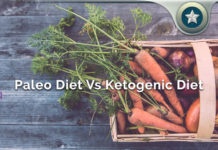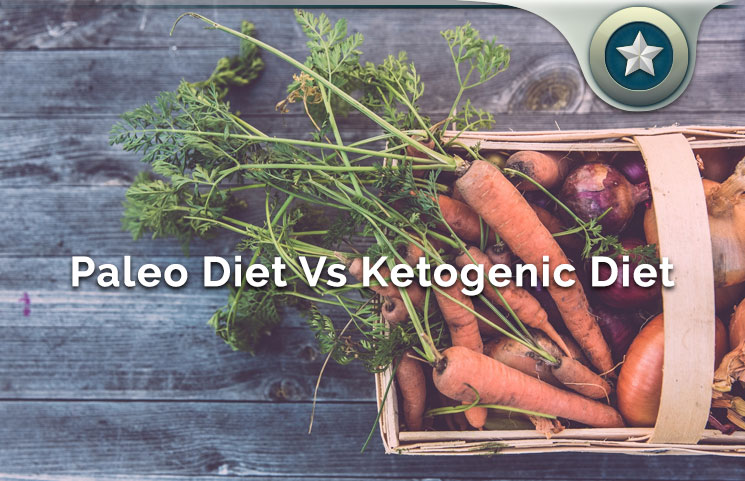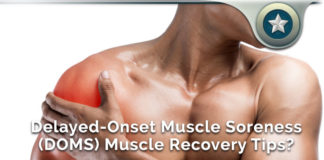If you’re reading this, chances are you’ve narrowed down your dieting options to between the paleo and ketogenic diets.
These are currently two of the most popular weight loss diets in the world, and for good reason too: they have been known to help adherents shed weight to become slimmer, fitter versions of themselves, as well as improve their overall health and sense of well-being.
However, both of these arrive at that goal using slightly different foods and recipes. Understanding the key differences between the two will help you make an informed decision.
What is the Paleo Diet?
The paleo diet is a low carb, high protein, and high fat diet designed after our cavemen ancestors’ diets. These tend to contain nutrient-dense foods known to deliver excellent nutrition whilst keeping the adherents fuller for longer. With paleo diet, you’ll eat small amounts of carbs, smaller amounts of food that have proven satiety properties.
This way, not only do you end up eating less, you also don’t have to eat frequently. This is possible because of the high slow digesting fiber contents of the average paleo meal.
There are three types/classes of paleo diets:
- Strict
- Normal
- Primal
All three have varying amounts of food groups that you would have to eat. Starters would do well to choose the normal first, and then move on to the others as they see fit.
The paleo diet is great for individuals who want a healthier lifestyle, reverse the metabolic syndrome –a combination of hormonal processes that often precede and result in chronic diseases- improve insulin sensitivity and lose weight in the process.
People who switch to this high protein based diet often record increased muscle gains, less bodily fat and overall improved health. The great thing about paleo diet is that anyone can get on it regardless of their health conditions.
This is because it is a more flexible dieting plan than the ketogenic diet and the relative availability of foods and their ingredients
What is the Ketogenic Diet?
The ketogenic diet was initially designed to help control and manage epilepsy in children, resulting in fewer or nonexistent seizure episodes in the process.
This is a high fat, moderate protein, very low carb diet that has gone mainstream as a result of its ability to aid weight loss and improved health.
The idea is to push the body into a state where ketones that are produced in the liver are converted into energy in place of the conventional carbs.
As a result, the body is compelled to burn fat faster, resulting in weight loss and a slimmer frame. Courtesy of this diet, ketone levels are ramped up in the body and the resulting energy utilized for your activities.
The protein levels in this diet has be somewhat moderate to prevent your body from turning non-glucose food substances like proteins into energy. The body has an energy source priority scale. It first seeks out carbs, then protein, and lastly, fats.
So, when it doesn’t find the first two, it resorts to the fats as its energy source. It draws from stored and dietary fats to produce the ketones that are then converted to energy.
If you need a formula for the carb, protein and fat distribution during every meal, that’d be as follows:
- Less than or equal to 10 percent carbs
- 10 to 15 percent proteins
- 70-80 percent fats
While it wasn’t called the ketogenic diet during their time, it’s what the ancestors depended on for survival during periods of food scarcity.
The ketogenic diet though, is a more specific diet as you have to consider certain factors such as individual metabolism rate and health conditions like type 2 diabetes and metabolic syndrome. Depending on your situation, you can opt for one of the three ketogenic diet classes:
- Standard
- Targeted
- Cyclic
The key to making the ketogenic diet work is by simply “tricking” your body into achieving ketosis. Doing this requires you to
- Limit carbs and protein intake to the barest minimum
- Ramp up on fatty foods consumption,
- Do some fasting
- Drink a lot of water
- Exercise for 20-30 minutes daily –simply walking briskly for that period is enough
- Avoid snacking as they tend to trigger insulin spikes
- Optimize with supplementation
You’ll know when your ketogenic diet starts working by
- The frequency of urination –the ketosis process also doubles as a diuretic
- Bad breath –usually smells like nail polish or ripe fruit- for a very short time
- Dry mouth or persistent thirst –which is why you should drink a lot of water
- Reduced hunger cravings and increased energy levels
Key Differences Between Paleo and Ketogenic Diet
Now that you’re familiar with both, what makes each of them completely different from each other? The major differences between both of them are as follows:
Ketone Levels
The ketogenic diet relies on you achieving ketosis to start reaping the benefits of the diet. Paleo diet doesn’t have anything to do with ketosis or ketones.
Quality of the Foods
The paleo diet places a lot of emphasis on the best quality and nutritionally rich foods available. The ketogenic diet’s emphasis isn’t particularly on this, even though it is generally assumed that enthusiasts would do their best to eat from good food sources.
Carbs Quantities
While they are both low in carbs, ketogenic diet depends on you to take very low carb quantities –less than or equal to 10 percent of your meals- in order to get your body into a state of ketosis. Paleo diet on the other hand is also low carb, but isn’t as low -15-35 percent.
Fat Quantities
The paleo diet does require you to eat fats, but not in quantities as high as that required by the ketogenic diet. In fact, the ketogenic diet requires fats to be about 75 percent or more of your meals.
There you have it… the key differences in both diets. In the next two sections, we’ll be looking at the pros and cons of both diets. This is to further help you make an informed choice about which one to choose, as they both have different requirements and processes, even if the goals are similar.
What are the Pros and Cons of Paleo Diet?
As one of the more popular weight loss and healthy living diets, paleo diet has both its benefits and disadvantages.
The pros of paleo diet include:
- Improves your health by eliminating junk foods from your meals and snacking
- Aids weight loss gradually and helps you pack on lean muscles –happens because of the protein consumption
- Stabilizes and regulates blood sugar levels
- Flexible, easy to adopt and implement. This makes it a great diet plan for both you and the family. And if you do a lot of traveling, it’s easy to continue with your paleo diet, even with limited options.
- Helps improve autoimmune diseases, digestive issues as well as clears up certain health conditions
- Increased nutritional benefits in the form of minerals and vitamins
- Clean eating without chemical additives
- Increased satiety and appetite suppression
- Foods are rich in antioxidants and anti-inflammatory foods resulting in an improved sense of well-being and fewer health conditions
The cons of paleo diet include:
- Cost implications, as the foods can be expensive
- Food types and sources may be somewhat limited
- The absence of dairy and adequate carbs may temporarily affect your energy levels
- Vegetarians in particular, may find it difficult to adhere to this diet as it contains no legumes
- Athletes typically require a lot more carbs than the amounts provided by paleo diet
What Are the Pros and Cons of Ketogenic Diet?
The following are some of the pros of the ketogenic diet:
- Excellent for rapid fat loss –this is perfect for detoxing after the holidays or getting in shape for an event
- Regulates blood sugar levels
- Has cognitive benefits in the form of increased focus and concentration
- Reduced food cravings
- Increased energy levels
- Helps with reducing epileptic seizures
- Lowers bad cholesterol levels and blood pressure
- Improves insulin resistance, lowering your chances of becoming diabetic and obese in the process
- Eliminates bad skin conditions, giving you an acne-free skin
- Combats inflammation
- May prevent metabolic disorders like obesity, diabetes and non-alcoholic fatty liver disease (NAFLD)
- Could prevent neurological diseases like Alzheimer’s and Parkinson’s
Cons of Ketogenic Diet
- Hard to follow as the foods are quite restrictive
- Participants tend to eat unhealthy fats
- Weight loss is most likely short term, so you may struggle with long term weight loss from keto diet
- Your diet will be missing considerable fiber, which as you know, is great for improving your satiety. But, that may not be necessary seeing as keto diet normalizes your appetite
- You may experience some discomfort during the first 7-14 days
- Not optimal for athletes and performance sportsmen who need significant amounts of energy to compete and perform
Side Effects of Paleo and Ketogenic Diets
As with all diets, your body is likely to suffer some side effects of switching to a different diet. Some of the side effects of these diets include:
- Low carb flu with symptoms like headaches, brain fog, crankiness, and fatigue
- Food cravings for carbs
- Ketoacidosis –excessive protein in the body in the case of paleo diet
- Cramps – mostly common in the keto diet and caused by protein deficiency
- Bad breath in both cases
- Possible low blood sugar arising from not taking adequate amounts of carbohydrates
- Possible bowel problems like diarrhea in the keto diet
- Loss of appetite
- Constipation –often experienced when on the keto diet
- Heart palpitations –experienced on the keto diet
These are some of the more common side effects of both diets. This way you know what to expect when you decide on one of these diets.
Since this guide would be incomplete without the foods, let’s explore the various food groups for each diet next.
Paleo Diet Food Groups to Eat and Avoid
The following are a list of foods you should eat if you’re following the paleo diet:
- Sweet potatoes
- Fruits and vegetables like kale, beet, peaches, cabbage, bananas, grapes, pineapples, apples, oranges, lemons, lime, strawberry, raspberry, blackberry, cherry, spinach and so on
- Lean meats like chicken and turkey
- Red meat like beef, steak and organ meats
- Seafood like fish, oysters, prawns and crayfish
- Seeds and nuts like chia seeds, flaxseeds, sunflower seeds, almonds, macadamia, walnuts and so on.
Foods to avoid include:
- Dairy products
- Wheat or gluten based foods
- Processed foods
- Refined sugar
- Vegetable and hydrogenated oils
- Legumes like beans
- Grains like rye, barley, white rice, oats, and maize
Keto Diet Food Groups to Eat and Avoid
The following are great foods you need to include in your keto diet:
- Avocados
- Meat –beef, steak, pork chops, pork loin, ground pork, and roasts
- Eggs
- Organs from meat like kidneys, liver, tongue and heart
- Fats and non-hydrogenated oils like coconut oil, virgin olive oil, butter, avocado oil, ghee, macadamia nut oils, lard, egg yolk and cocoa butter
- Cold-pressed vegetable oils like safflower oil, flaxseed oil and soybean oil
- Chicken, quail, pheasant, ostrich and duck as well as other free range or wild caught poultry
- Fish like salmon, tuna, cod, catfish, mackerel, trout, bass and flounder
- Dairy products like whipped cream, mayonnaise, soft and hard cheese, greek yoghurt, sour cream and cottage cheese
- Nuts and seeds like pecan, almonds, hazelnuts, macadamia nuts, brazil nuts, chai seeds, flax seeds and poppy seed
Foods to avoid in your keto diet include:
- No refined sugars or anything very sweet including fruit juices
- High concentration carbs
- Processed foods
- High sugar content fruits like pineapples and bananas
- Soy products
So, Which One is Best for You: Paleo or the Ketogenic Diet?
Well, it completely depends on your goals. If you’re looking to jumpstart your weight loss process, use the ketogenic for a while, then sustain that weight loss with the paleo diet.
If you want to improve your health and overall well-being, go for paleo. If you have epilepsy and need to minimize seizures, the ketogenic diet is best. As you can see, they can actually complement each other if you want.
However, if it’s the lifestyle you want, well, many people can’t stand not eating carbs, no matter how small. For these people, the best would be paleo diet.
Those who are extremely obese and don’t mind the minimal carb intake, might probably find the ketogenic diet best for their needs. As you can see, they both work. You just have to find that which works for your unique situation and decide.









